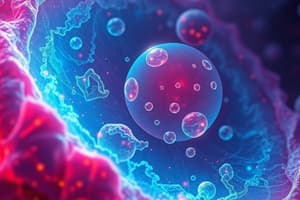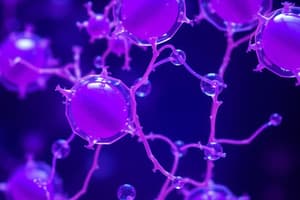Podcast
Questions and Answers
What is cytoplasm?
What is cytoplasm?
- A membrane that surrounds and protects the cell
- A sac filled with digestive chemicals
- A structure that organizes motion of chromosomes
- A jelly-like substance within the plasma membrane (correct)
What is the function of lysosomes?
What is the function of lysosomes?
Sac filled with digestive chemicals
What do mitochondria do?
What do mitochondria do?
Convert nutrients to energy
What is the role of centrioles?
What is the role of centrioles?
What is the endoplasmic reticulum?
What is the endoplasmic reticulum?
What do vacuoles store?
What do vacuoles store?
What does the cell membrane do?
What does the cell membrane do?
What is contained in the nucleus?
What is contained in the nucleus?
What is the function of ribosomes?
What is the function of ribosomes?
What protects the nucleus?
What protects the nucleus?
What does the Golgi apparatus do?
What does the Golgi apparatus do?
What is a vesicle?
What is a vesicle?
What does the nucleolus synthesize?
What does the nucleolus synthesize?
Flashcards are hidden until you start studying
Study Notes
Cell Structure and Functions
- Cytoplasm: A jelly-like substance located within the plasma membrane, providing a medium for biochemical reactions.
- Lysosome: A sac filled with digestive chemicals responsible for breaking down waste materials and cellular debris.
- Mitochondria: Known as the powerhouse of the cell, these structures convert nutrients into energy through cellular respiration.
- Centriole: An organelle that plays a crucial role in organizing the motion of chromosomes during cell division.
Cellular Components
- Endoplasmic Reticulum: A network of passageways where various chemicals, including proteins and lipids, are synthesized and transported within the cell.
- Vacuoles: Sac-like structures that store water, nutrients, or waste products, playing a key role in maintaining cellular homeostasis.
- Cell Membrane: A protective barrier that surrounds the cell, controlling the movement of substances in and out.
- Nucleus: The control center of the cell, containing DNA, and directing activities such as growth, metabolism, and reproduction.
Protein Synthesis and Packaging
- Ribosome: Tiny structures responsible for synthesizing proteins from amino acids, essential for cell function and repair.
- Nuclear Membrane: A double-layer membrane that protects the nucleus, regulating the exchange of materials between the nucleus and cytoplasm.
- Golgi Apparatus: A stack of membranes involved in packaging and modifying chemicals, such as proteins and lipids, for secretion or delivery to other organelles.
- Vesicle: A small package created by the Golgi apparatus for transporting cellular materials to their destinations.
- Nucleolus: A small, dense structure within the nucleus responsible for synthesizing ribosomal RNA (rRNA) and assembling ribosomes.
Studying That Suits You
Use AI to generate personalized quizzes and flashcards to suit your learning preferences.



